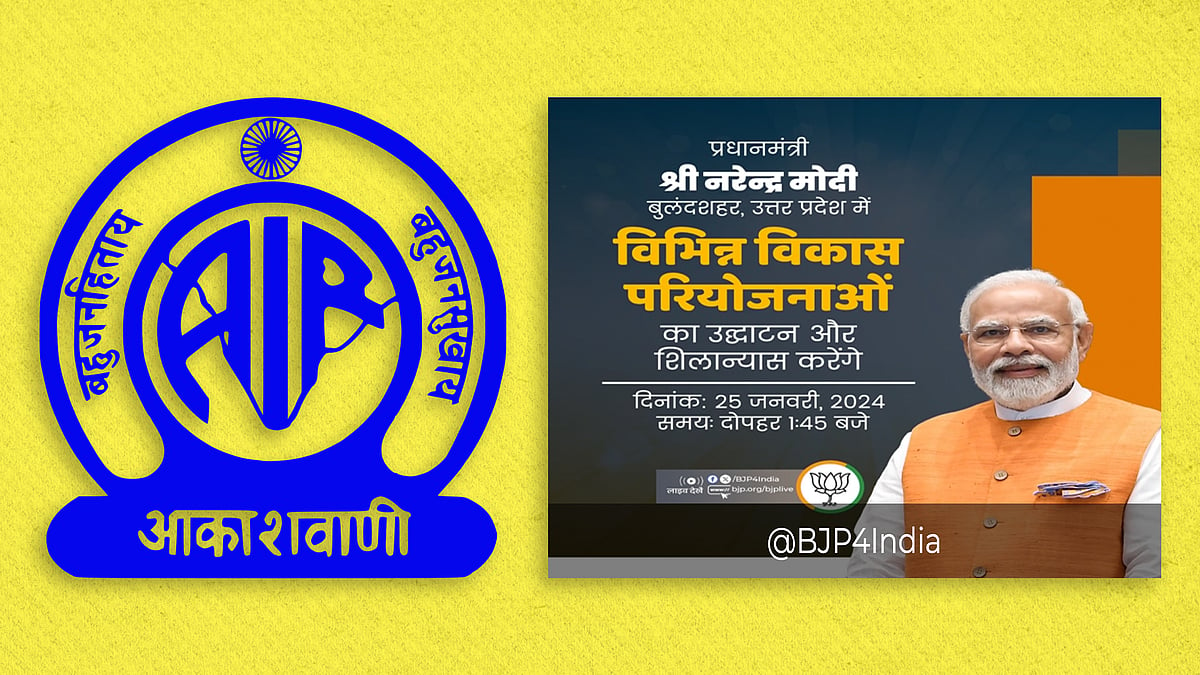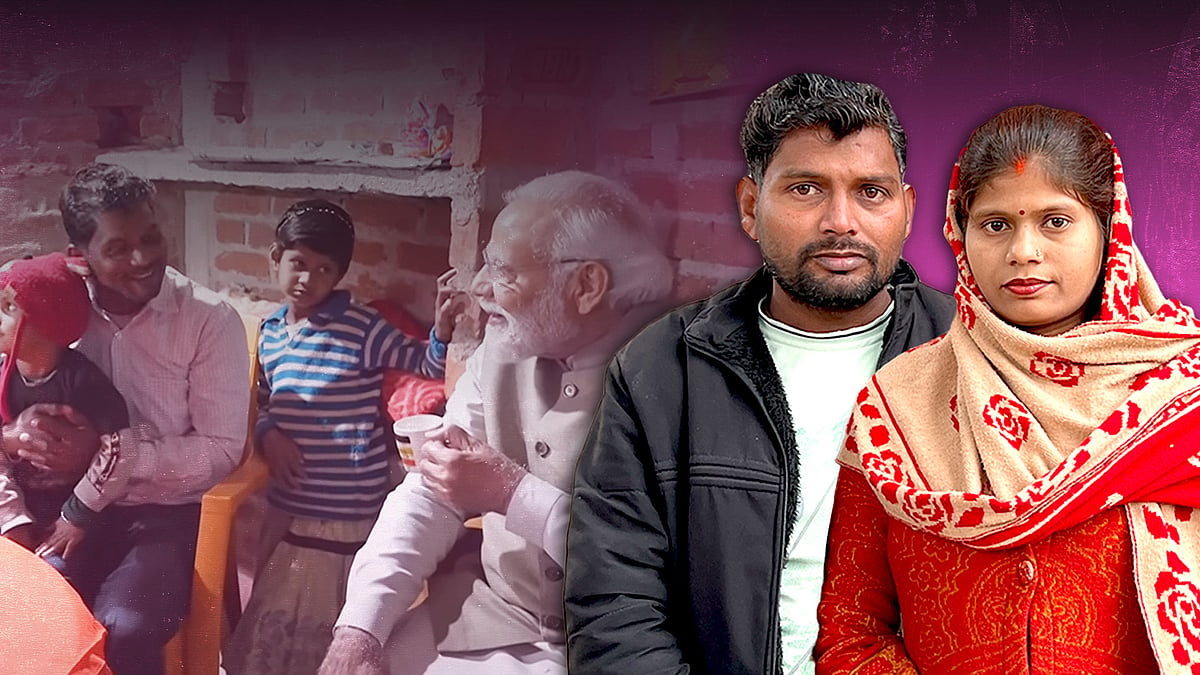From ‘path-breaking’ demonetisation to Bal Narendra’s heroics: Hits and misses of Modi museum
Modi gallery is ostensibly the first Indian museum dedicated to a governing PM.
A bigger than life-size digital board plastered with a beaming face of Prime Minister Narendra sets the stage for the newly-opened Narendra Modi gallery at its entrance at Prime Ministers’ Museum and Library Society in Lutyens’ Delhi.
The museum, a digital documentation of Modi’s life, depicts him as an obedient son, ascetic, diligent RSS and BJP worker, a rather compassionate chief minister, globetrotter and the Indian PM scripting the Vishwaguru narrative.
It is ostensibly the first Indian museum dedicated to a governing prime minister. A part of the new building named ‘Pradhanmantri Sangrahalaya’ – which recounts the contributions of all prime ministers through hi-tech tools in chronological order – the museum on the ground floor is dedicated to Modi and the ‘making of a leader’. It informs visitors that Modi is a skilled swimmer and his mother had an immense influence on him.
But for anyone looking for more details on Bal Narendra braving crocodiles, or the alma mater of Modi, who graduated with a “degree in political science”, they are in for a disappointment. To state the obvious, Gujarat riots and Covid deaths are a far cry.
What instead line the video panels are Modi’s welfare schemes, his foreign tours, and reforms and advancements across sectors from economy to agriculture, science, and technology. His role in the increase in India’s forest cover, and ‘foundation of new India’ also find mention. The curators, however, gave farmers protest, and GST and demonetisation “misadventures” a miss.
What did Newslaundry really see at the gallery, and what else did the curators miss? Let’s take a look.
2014 vs 2024
The digital panels scream astronomical numbers at visitors, drawing parallels between 2014 and 2022 – a sore thumb that sticks out across the gallery.
“Foreign direct investment in India grew from $45 billion in 2014-15 to $85 billion in 2021-22 – the highest ever,” declares an audio-visual panel commending the government’s Atmanirbhar Bharat, or self-reliant India campaign.
It recounts: Defence exports have leapfrogged by 23 times, from a measly $2 million in 2013-14 to $1 billion in 2022-23. The panel does not leave out exports, which grew “from $462 billion in 2013-14 to $776 billion in 2022-23”.
The seemingly arbitrary list then states that mobile manufacturing units have risen from just 2 to more than 200 in the past nine years.
In the environment pavilion, the voice-over waxes lyrical about Modi’s sustainable development push. It does not miss to mention his “influence in the global climate change discourse” as a miniature model of a city changes colours. It ironically shows as many trees as residential buildings and industry blocks.
The past and the present meet here too.
A spirited voice-over announces: “Tiger population has increased from 2,226 in 2014 to 3,167 in 2023.” Notably, the country recorded the highest number of tiger deaths in 2023.
The rise in forest cover over the past 10 years is also attributed to Modi’s leadership. However, it misses to mention the contentions around it. Experts have questioned the “new methodology” of counting trees in the country, noting that the new survey counts the trees in cities and plantations as “forest cover”.
Appealing more to the imagination than reality, a panel declares a “rejuvenated” Ganga is being “restored to its pristine glory,” ensuring a happy ending for the dolphins.
“A symbol of purity, the Ganga is being restored to its pristine glory. Since its rejuvenation, new life is visible in the river with the return of aquatic species like dolphins,” says the audio.
Notwithstanding the claim, the clean Ganga mission remains a work in progress. As of September last year, only 20 percent of the sewage flowing into the river was being treated.
Bal Narendra, graduation and Gujarat riots
The heart of the gallery talks about Modi’s childhood – “the making of a leader”.
An LED screen circles an artificial banyan tree, while Modi’s pictures of his childhood and adulthood are displayed on the screen. It also features his mother, and mentor and RSS veteran Laxmanrao Inamdaar.
Modi developed a penchant for learning after seeing his father read Ramayan and other religious texts, blares a speaker. “Narendra liked to read and was considered a good debater. Wiry and athletic, Narendra was also a good swimmer and participated in team sports.”
His childhood heroics of wrestling with crocodiles, as mentioned in one of his 17 real life stories in comic book ‘Bal Narendra’, does not make it to the script at the gallery.
Narendra used to help his father at his tea shop at Vadnagar railway station, while his mother Heeraben supplemented the family income by working in neighbouring houses, the visitors are informed. “The young Narendra was deeply affected by the hardships of his mother. Her work in a smoke-filled kitchen took a toll on her health.” This points to how Modi’s personal experiences inspired his welfare schemes like the Ujjawala Yojana for setting up gas pipelines.
The audio recounts Modi’s journey into the “path of service,” with the help of monks and religious gurus. The script then moves on to his association with the RSS. “At 20, Narendra formally joined the RSS in Ahmedabad and served the poor across the state.”
It then informs that Modi “completed a political science degree” in 1972. It does not mention his alma mater or the affiliated university.
Notably, the Aam Aadmi Party has been targeting Modi for an alleged “fake degree”.
The narrative subsequently shifts to his political journey and participation in agitations and rallies. A clip of Modi taking oath as Gujarat chief minister beams on the curved LED.
It also recounts the difficulties endured by the state around his tenure, including the Bhuj earthquake, and subsequently, the chapter on the making of a leader ends. The 2002 Gujarat riots are skipped.
Demonetisation, GST and Covid
“Prime Minister Narendra Modi implemented pragmatic structural reforms to transition India from the ‘Fragile Five’ and establish it as the world’s fastest growing major economy.” The untiring voice-over continues to laud PM Modi in the pavilion of ‘Good Governance’.
GST turned India into a land of “one nation, one tax,” the visitors are told, not getting into the nitty gritties of the roadblocks faced in its implementation.
“Path-breaking” demonetisation also makes a cameo.
“Prime Minister Modi’s path-breaking decisions such as demonetisation were decisive measures to move towards a formal economy.” It does not divulge more. But for the record, the primary aim of demonetisation, as announced by PM Modi in November 2016, was to end the circulation of black money and terror-funding.
Notably, the policy has been widely-criticised for failing to fulfil its primary objectives. In an interview with Newslaundry, former finance secretary SC Garg termed the move a “misadventure”.
The high praise does not stop there. It goes on to count PM Modi’s achievements in labour reforms, social security coverage, public sector banks mergers, insolvency and bankruptcy law, and production-linked incentives. The list is ostensibly inexhaustible.
In the science and technology pavilion, two miscroscopes with headphones explain how vaccines fight coronavirus. The “timely lockdowns” are hailed. There is also praise for special trains for migrant workers and the government's vaccination efforts.
Citing a study, the voice-over says that the lockdown brought down Covid cases by 60 percent, but it avoids mentioning the deaths and reverse migration of hundreds of thousands of migrants.
On the mystery of PM Cares Fund, the LED panel says that it was “initiated to raise funds for the public health emergency” during the pandemic. So, how were the funds used? While the government audit reports show that a portion of the funds were utilised during the pandemic, Prime Minister’s Office turned down the RTI applications seeking details. The PMO argued that the PM Cares Fund is not a “public authority”.
Nehru’s appearance and J&K
The anonymous voices coming from speakers claim that PM Modi’s schemes have laid the foundation of “modern welfare society” and “liberated women from smoke”.
Besides lauding the welfare schemes, another achievement the voices account for is the abrogation of Article 370 and 35A. In this segment called ‘Abrogation of Article 370: End of an Anomaly’, India’s first Prime Minister Jawaharlal Nehru also makes an appearance.
Nehru appears as the voice-over harks back to 1949, when the special status was granted to Jammu and Kashmir. The audio says: “It ( Article 370 and 35A) diminished the rights of women, refugees from outside Kashmir and citizens from other states… The Narendra Modi-led government introduced a resolution to repeal Article 370 in the Lok Sabha to eliminate this discrimination and strengthen national integrity and unity.”
Moving on to the pavilion on foreign affairs, Modi is credited for “Balakot airstrikes” across the border in Pakistan after the Pulwama attack in 2019. It also features Modi’s photos from his 57 foreign tours as the prime minister.
Towards the end of the gallery, there are three cubicles to listen to 150 clips from Modi’s Mann Ki Baat, Jan Samvaad and Parikshan Pe Charcha.
A collage of digital panels shows ‘Foundation of New India’ – the new parliament building, AIIMS Guwahati, Kedarnath temple redevelopment, Kashi Vishwanath Corridor, HAL factory in Karnataka, and the Rajkot greenfield airport.
In the old building, the Nehru gallery also has similar displays as how he built a new India by setting IITs and AIIMS.
But how are visitors responding to the Modi gallery?
A visitor’s diary answers this. The first three comments in it are from Jammu and Kashmir Administrative Services officials, all paying glowing tributes to the museum.
In times of misinformation, you need news you can trust. We’ve got you covered. Subscribe to Newslaundry and power our work.
This report was published with AI assistance.
 Broadcast code violation? AIR uses image with BJP symbol to report on Modi scheme launch
Broadcast code violation? AIR uses image with BJP symbol to report on Modi scheme launch Ram’s Ayodhya has gone the Modi way. What do locals think?
Ram’s Ayodhya has gone the Modi way. What do locals think? ‘No toilet, drowning in debt,’ says Ayodhya Dalit woman who hosted Modi for tea
‘No toilet, drowning in debt,’ says Ayodhya Dalit woman who hosted Modi for tea